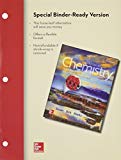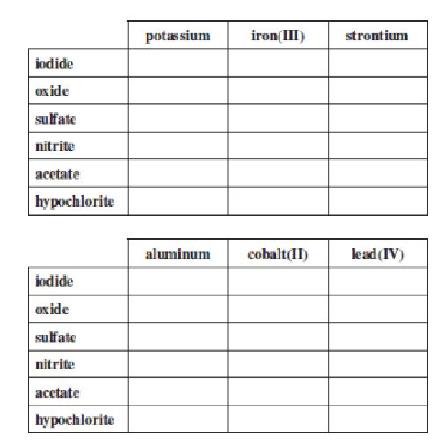
Concept explainers
Complete the following table by writing formulas for the compounds formed when the cations listed across the top combine with the anions listed along the side.

Interpretation:
The given cations combine with anions to form chemical formulas are to be analyzed.
Concept Introduction:
An ionic compound consists of metal cation and a non-metal anion. The rules that are used for determining the chemical formula of ionic compounds are as follows:
First, identify the symbol of the elements in the periodic table.
Identify the charges on the cation and the anion.
After that, the symbol of the cation is written followed by that of the anion.
It is very important that the compound is electrically neutral or the charges of anions and cations are neutralized in the compound.
Explanation of Solution
Given Information:Table is provided in the question.
Potassium cation
The potassium, iron(III), strontium, aluminum, cobalt(II), and lead(IV) cations are combined with iodide, oxide, sulfate, nitrite, acetate, and hypochlorite anions to form chemical formulae of ionic compounds that are shown in the above table.
Want to see more full solutions like this?
Chapter 3 Solutions
Combo: Loose Leaf for Introduction to Chemistry with Connect Access Card Chemistry with LearnSmart 1 Semester Access Card
- Which of the following statements is/are always true? Never true? Usually true? (a) Compounds containing chlorine can be either molecular or ionic. (b) An ionic compound always has at least one metal. (c) When an element in a molecule has a di prefix, it means that the element has a +2 charge.arrow_forwardExplain how an anion can behave like an acid. Is it possible for a cation to be an acid?arrow_forward
 World of Chemistry, 3rd editionChemistryISBN:9781133109655Author:Steven S. Zumdahl, Susan L. Zumdahl, Donald J. DeCostePublisher:Brooks / Cole / Cengage Learning
World of Chemistry, 3rd editionChemistryISBN:9781133109655Author:Steven S. Zumdahl, Susan L. Zumdahl, Donald J. DeCostePublisher:Brooks / Cole / Cengage Learning Introductory Chemistry: A FoundationChemistryISBN:9781337399425Author:Steven S. Zumdahl, Donald J. DeCostePublisher:Cengage LearningChemistry: Matter and ChangeChemistryISBN:9780078746376Author:Dinah Zike, Laurel Dingrando, Nicholas Hainen, Cheryl WistromPublisher:Glencoe/McGraw-Hill School Pub Co
Introductory Chemistry: A FoundationChemistryISBN:9781337399425Author:Steven S. Zumdahl, Donald J. DeCostePublisher:Cengage LearningChemistry: Matter and ChangeChemistryISBN:9780078746376Author:Dinah Zike, Laurel Dingrando, Nicholas Hainen, Cheryl WistromPublisher:Glencoe/McGraw-Hill School Pub Co Chemistry: The Molecular ScienceChemistryISBN:9781285199047Author:John W. Moore, Conrad L. StanitskiPublisher:Cengage Learning
Chemistry: The Molecular ScienceChemistryISBN:9781285199047Author:John W. Moore, Conrad L. StanitskiPublisher:Cengage Learning Chemistry & Chemical ReactivityChemistryISBN:9781337399074Author:John C. Kotz, Paul M. Treichel, John Townsend, David TreichelPublisher:Cengage Learning
Chemistry & Chemical ReactivityChemistryISBN:9781337399074Author:John C. Kotz, Paul M. Treichel, John Townsend, David TreichelPublisher:Cengage Learning Introductory Chemistry: An Active Learning Approa...ChemistryISBN:9781305079250Author:Mark S. Cracolice, Ed PetersPublisher:Cengage Learning
Introductory Chemistry: An Active Learning Approa...ChemistryISBN:9781305079250Author:Mark S. Cracolice, Ed PetersPublisher:Cengage Learning





